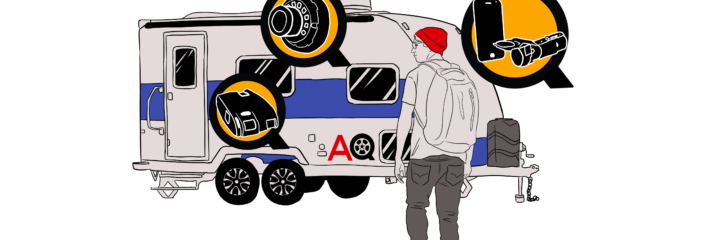Brakes are something you don’t really want to think about. That’s because usually if you are thinking about them, it means they aren’t working so well. Trailer brakes are no exception. When you tow a heavy load, you don’t want to be wondering whether or not the trailer will stop. The first step towards peace of mind is when towing is making sure you have a good brake controller. If you don’t have one, then good news. This guide is for you.
- Tips on Choosing a Trailer Brake Controller
- Top 10 Best Trailer Brake Controllers 2026
- 1. Best Overall Brake Controller: Tekonsha Primus IQ
- 2. Best-Looking Brake Controller: Curt Spectrum Original
- 3. Best Premium Brake Controller: Tekonsha Prodigy RF
- 4. Best Budget Brake Controller: Reese Towpower
- 5. Most High-Tech Brake Controller: Curt Echo Mobile
- 6. Best Trailer Mounted Brake Controller: Autowbrake Plug and Tow
- 7. Most Durable Brake Controller: Curt TriFlex
- 8. Most Compact Brake Controller: Reese Towpower Compact IQ
- 9. Best Cheap Brake Controller: Curt Venturer
- 10. Best In-Dash Brake Controller: Ensun In-Dash
- The Full Guide to Trailer Brake Controllers
- Enjoy a Worry-Free Adventure
Tips on Choosing a Trailer Brake Controller
Since trailer brake controllers are all supposed to do the same thing – bring a trailer to a stop – there isn’t much variety in how they function. That’s good; it means no matter what you choose, you will get something that works.
The most significant ways they differ concern how they mount, how you use them, and how much control they give you. If you know what you’re looking for, you can jump straight to our reviews. If not, read on and we’ll go over the key things to think about.
Mounting Locations
This is the most straightforward category since it just concerns where you put the thing. It is probably one of the biggest influences on choosing a controller. It directly affects how easy it will be to install and whether or not it will fit your lifestyle.
Under Dash
Under dash boxes are the most common brake interface. They are often simple black boxes with some LEDs on them, and they hang down near the steering wheel for easy access while you drive.
In-Dash
In-dash modules can be bought in two ways. Universal modules are simple dials or buttons that you mount in your dash after drilling a hole or finding an empty space. Check out the Spectrum controller on our list for an example of this type.
The other way to get an in-dash button is to buy a controller meant to work with your vehicle. Most trucks have accessory bays in the dash already. All you have to do is buy the right module for your year and model and click it in. We have one on our list for an F150, but there are a lot more out there.
Trailer Mount
Some brake controllers mount directly to the trailer. These tend to be expensive but powerful. Sometimes they include wireless controls, like the Autowbrake controller that we recommend. Sometimes they just don’t have any controls and rely entirely on sensors to operate.
Formats and Interfaces
There are only 3 controls you really need on a brake controller: one for the power level, one for sensitivity, and one for emergency braking. Some controllers will have more options. Advanced controllers may have modes that you can select. Timed controllers will have a separate way to set the time it takes for the brakes to come on.
What will change from unit to unit is how you operate those controls. The levels will either be controlled by a + and – button or a little thumb dial. The emergency stop is most often a slide switch, but some companies use a much more simple button press.
Uncommon Interfaces
The interfaces do sometimes get crazy. The Echo controller we recommend uses your cell phone to control it – so you get a full touch screen interface. The monster Tekonsha module we recommend uses a funky walky-talky looking thing as the interface.
Other Features to Consider
Since sending a signal to a brake system is not a complicated process, once you’ve decided on how you want to install it and how you want to interact with it, you are pretty much there.
That being said, there are still other features and words you will come across as you research them, so we’ll touch on them here.
Proportional vs. Timed
Trailer brake controllers can either be proportional or timed. Proportional is the ideal way to go about it. In fact, we only recommend one timed controller, and even then, we don’t suggest it for anything other than occasional towing. We go way more in-depth in our full guide if you are curious.
Wireless
Wireless controllers don’t have wires that need to run from the dash to the trailer. Most of them still have wires though, either for plugging the receiver into the trailer itself or to power the transmitter. Except for the Echo controller, which is really, truly wireless.
Axles
Trailer brake controllers can only control a certain number of brakes. They express this number by telling you the number of axles they support. A three-axle controller can support six brakes since each axle will usually have two brakes. Almost all controllers nowadays are three or four axles rated, so it’s not something the average person needs to be concerned about. If you have a five-axle trailer, you probably know more about towing than this guide might be able to teach you.
Leveling, Sensing, and Accelerometers
This category gets really complicated, so we’ll go over it more in our full guide. All trailer controllers have some manner of sensors to tell when they need to engage. It’s best to let the manufacturer figure out what the most effective sensors for their unit are.
With the basics out of the way, let’s get into the products. Like with most review lists, you should choose the one that fits your situation best, not the one we like the best. We have to balance a lot of factors, like price and accessibility. We’ve made our best effort to bring all the relevant things to your attention, but only you can decide which features are the most important to you.
Top 10 Best Trailer Brake Controllers 2026
1. Best Overall Brake Controller: Tekonsha Primus IQ
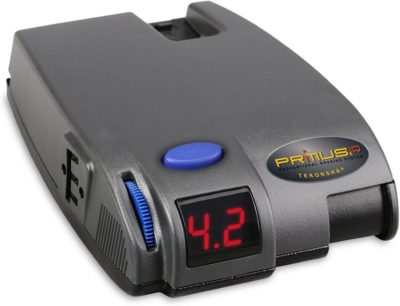
Editor’s Rating:
Where It Goes
The Primus IQ is your everyday standard under-dash mounted black box controller. You bolt the bracket to wherever you can reach from the driver’s seat and then attach the controller to the bracket.
The only thing that sets this Tekonsha apart compared to the very similar Curt controller is that it also includes a snap-in bracket for even more mounting options. You don’t have to only mount it under a surface. If you have space, feel free to attach it wherever you can.
How to Use It
This is a super standard, straightforward unit. You squeeze the slide button to activate the brakes manually, and the sensitivity is automatically calibrated. You can boost the power level temporarily by pressing the button on the top and cycling through a few different modes, and you can adjust the power level with the little dial on the side.
The LED display on the front is easy to read, and it will display problem codes if you have a problem. All in all, it’s just a really simple, easy to use unit. Even if you know nothing about trailer brake controllers, you can probably get into a vehicle with this unit and figure out how it works.
Our Thoughts
Oftentimes for us it comes down to the answer to one question: if you could only recommend one unit, which one would it be? It would have to be the product most likely to work for everyone. It would also have to be intuitive to use, and it can’t be too expensive. It might not be the best at any one thing, but it will probably work for anyone.
That’s what the Primus IQ is. It’s not the highest quality. In fact, the plastic might wear out and snap over time, and the manual override button sometimes feels terrible. Check out the Curt controller if you need more durability. The Primus also isn’t the cheapest on our list. That honor goes to the only timed option we recommend here.
It does represent the best balance between features, quality, usability, and price. And that’s why we can safely say that if you only want one option, it’s the Tekonsha Primus IQ.
Pros
- Great value
- Easy to use
- Comes with multiple mounting options
Cons
- Doesn’t feel very sturdy
- The brake button doesn’t inspire confidence
2. Best-Looking Brake Controller: Curt Spectrum Original
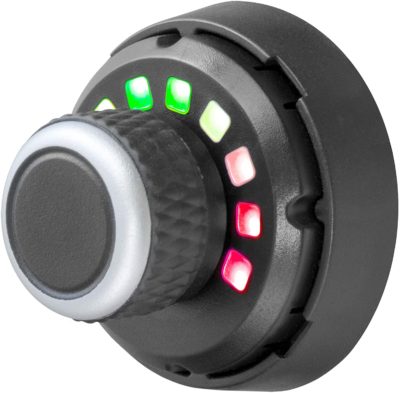
Editor’s Rating:
Where It Goes
The Curt Spectrum is actually two individual units. A box that can be mounted anywhere, and a dial that you should mount somewhere on your dash. By separating the box and the controls, you can do a super clean install and make it look like a factory feature.
How good it looks all comes down to how much DIY you want to do. Even if you just stick the control knob onto the face of a blank panel, it will still look better than an under-mount unit like the Tekonsha controller Where it can really get amazing, though, is if you are willing to drill a hole and mount that knob through a blank panel. That’s how you make it look like it came from the assembly line with it installed.
How to Use It
Since the only control the Curt Spectrum controller has is a single dial, it’s safe to say that the thing is pretty easy to use. You press it like a button to apply the brakes manually, and you turn the dial to change the power. It will calibrate itself, so you don’t even need to do that.
The downside is that the push button only comes on at full power, so there is no proportional braking if you need to override the sensors. That’s usually not a huge issue; if you have to come to an emergency stop, you want all the power you can get. If you do a lot of gravel or snow driving and you want ultimate control, though, go ahead and grab something like the more traditional Tekonsha Primus controller we recommend.
Our Thoughts
We love it when a product looks good inside the cab of the vehicle. We also love it when a product is super easy to use. The Curt Spectrum is both. In fact, we are confident in saying that it’s the easiest to use controller on our list. The LED lights fill up like a volume bar to display the power, so you don’t have to decipher arbitrary numbers. It doesn’t have any other buttons or switches.
It does cost a lot, though. It works great, and it’s worth the price, especially if you really value how the interior of your vehicle looks. There is one other unit like the spectrum on our list, and it’s cheaper. It’s made by Reese, but it definitely doesn’t look nearly as good.
Pros
- Looks great
- Very easy to use
- Self-calibrating
Cons
- Brake override is either on or off
- A little expensive for a standard controller
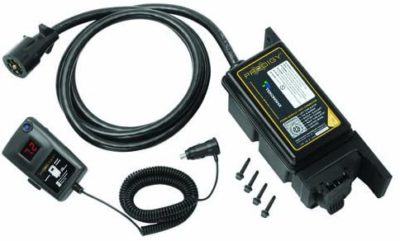
Editor’s Rating:
Where It Goes
The brain of the Tekonsha Prodigy mounts directly to your trailer. It ties directly into the wiring of the trailer and takes over as the main interface between your vehicle and the trailer’s electrical. We do mean take over, too. You have to rout the lights, brakes, and signals into the Tekonsha box since it also replaces your trailer’s connection cable. If that sounds like more DIY than you want to do, take a look at the Echo controller instead.
The actual controls are mounted to a wireless controller that sits in your cabin, or anywhere with a 12v outlet. It’s just a simple handheld box that looks kind of like the mouthpiece to an old CB radio.
How to Use It
The biggest advantage of a trailer-mounted control box is that you can tow the trailer with any vehicle and still control the brakes. That does give it an edge in usability over many other gadgets just because you don’t have to calibrate or change the settings very often.
However, the wireless element to it can add some frustrations. Like when your phone refuses to pair with your BT radio, the controller will sometimes just refuse to play nicely. It’s not a problem once it’s paired, but it just gets picky sometimes when you unplug the 12v source to the controller.
Our Thoughts
The dominating feature of the Tekonsha when you compare it to other trailer brake controllers is the price. We hate pointing that out because it’s really, really good, but it’s impossible to ignore. It’s also harder to install than other units, it takes more learning to use, and it only works with one trailer.
The benefits, though, can quickly make up for the hefty price tag. First off, if you have something like a shared trailer for horses or a boat, then there’s no substitute for a unit like this that can be used by any vehicle. We do mean any vehicle. Since you wire it directly into the trailer, you can configure it to work with trucks and SUVs that don’t have a tow package at all.
Second, it’s probably the best brake controller in terms of functionality on our list. It auto-calibrates itself, has a ton of advanced sensors for smooth operation, and is bulletproof. If you have really important cargo, like horses, it’s best to splurge a little and get that extra quality.
Pros
- High-quality
- Attaches to the trailer instead of the vehicle
- Can be used with vehicles that have no factory controller wiring
Cons
- Very expensive
- Has a complicated install process
4. Best Budget Brake Controller: Reese Towpower
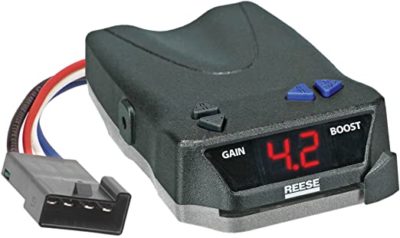
Editor’s Rating:
Where It Goes
The Reese Towpower is another standard, under-mount brake controller. There’s nothing special about the way it installs; you just anchor the bracket to the underside of a surface.
It is a pretty cheap, simple bracket. You can’t even adjust the controller’s angle, rather it just hangs there from a couple screws. That can be kind of annoying, especially if you pump it with your knee and accidentally loosen it up.
How to Use It
There is a plus and minus button to control the boost, and there is a separate set of plus and minus buttons to control the gain. The brake override is a simple slide switch.
Other than that, there are no hidden cool features or presets. You set all the options, and that’s what you get.
What really sets it apart from other budget options is that it’s still a proportional system, not a timed system. That alone means it’s easy enough to use. You don’t have to mess with it too much; there’s no synchronizing or timing you have to worry about. Just make sure the wheels on the trailer don’t lock when you come to a stop while driving.
Our Thoughts
The Reese Towpower is not the cheapest controller on the list. The cheapest controller on the list is the Curt Venturer, but it is time-based, and you don’t want that. We live in the future now. Proportional braking is safer and more comfortable to drive with than timed.
It is the least expensive proportional unit, though. That’s perfect if you need a brake controller, and you are on a budget. The buttons might break, the LED display might blink on and off sometimes, but it’ll control your trailer brakes just fine.
Pros
- Inexpensive
- Easy to use
- Easy to install
Cons
- Mount isn’t very good
- Build quality is pretty low
5. Most High-Tech Brake Controller: Curt Echo Mobile
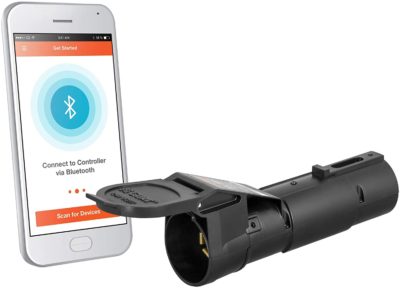
Editor’s Rating:
Where It Goes
The Curt Echo is perhaps the craziest piece of tech that we have on our list, and frankly, we just think it’s neat to share the fact that it exists with people. One of the biggest reasons that it’s kind of crazy is because of where it mounts. It plugs into your trailer plug on your car, and then the trailer plugs into it.
That’s it. It doesn’t need mounting, wiring, or a dedicated vehicle/trailer. You control it with your phone, so there isn’t anything else to it. Plug it in, done.
How to Use It
This device is probably the most polarizing unit when it comes to ease of use. If you are familiar with app-controlled devices, you won’t have any issues. You install the app, pair it with the device, and follow the instructions on the screen.
People who don’t often use their cell phones to control gadgets might find it frustrating. BlueTooth can sometimes be a pain in the butt, cell phones can be a pain in the butt, and combining the two can be a pain in the butt. If you are not the type of person who is willing to troubleshoot connectivity issues, just get the Autobrake wireless brake controller instead. It comes with a key fob, no app needed.
The one thing that might piss everyone off is the big brake override button. While you are running the app, the brake override button is just a big button in the center of the screen, which is fine if you have your phone mounted in a place where you can reach it. It goes away if you get a call or drop your phone, and then you have no override button. That is not ideal.
Our Thoughts
There are some people who value new, innovative gadgets over tried and true tools. Some of them tow the occasional trailer, and the Echo was designed for them. It’s definitely not for everyone. People who aren’t into using their cell phones for everything or people who tow a lot of trailers will prefer a more traditional brake controller. Tech nerds, though, will absolutely love this thing.
Pros
- Works on any vehicle
- Works on any trailer too
- Really easy to use if you are comfortable using cell phone apps
Cons
- Really terrible to use if you are not comfortable using cell phone apps
- The override button can disappear if you get a call
6. Best Trailer Mounted Brake Controller: Autowbrake Plug and Tow

Editor’s Rating:
Where It Goes
The Autowbrake is another trailer-mounted controller. Naturally, that means it mounts to your trailer rather than inside your truck or SUV.
Unlike our other trailer-mounted brake controller, you don’t have to replace the existing cable if you don’t want to. You can just splice this one in, which is a little easier than replacing the entire junction box.
We do recommend replacing the whole junction box with a new self-enclosed cable, like this one. It’s the sort of thing where if you are going to go through all the trouble to install this wicked-awesome brake controller, you might as well go the distance and make the wiring really neat and tidy too.
How to Use It
There are two separate processes when using the Autowbrake controller. The first process, the initial calibration, can be a bit tricky. The best way to understand is to just watch one of their representatives explain it. You have to calibrate every single brake controller on the market. The Autowbrake is just a little less intuitive than other units.
The good news is that the process of using it after you calibrate it is ridiculously easy. You get a keyfob with the controller. On the keyfob is a button in the center for the brake override, an up arrow to turn the braking force up, and a down arrow to turn the braking force down.
Our Thoughts
Can we be honest with you for a moment? The Autowbrake both costs less than the Tekonsha Prodigy controller, and it’s the one we’d recommend between the two. The Tekonsha is a little sturdier, and the remote control does give you more options than the Autowbrakes key fob. Also, there is less of an established user base for this controller. At the end of the day, though, the Autobrake is easier to work with and looks better. Call us vain, but we like saving money and looking good.
Pros
- Attaches to the trailer instead of the car
- You don’t have to replace the trailer cable if you don’t want too
- The key fob controller is neat and easy to use
Cons
- Calibration is a little complicated
- Even though it’s easier to install than the other wireless unit, it’s still not easy to install
7. Most Durable Brake Controller: Curt TriFlex
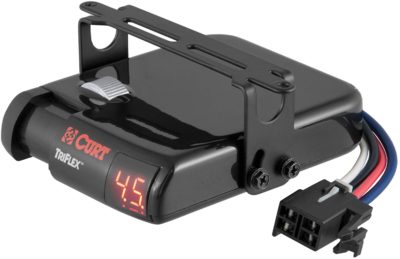
Editor’s Rating:
Where It Goes
This is another one of those standard, under-mount controllers. Just like the Tekonsha Primus, it’s got a metal bracket that attaches to any surface, and then you attach the controller to the bracket. You splice it into the existing tow wiring, or you buy an adapter cable.
How to Use It
It’s got a single dial and a squeeze switch for the brakes. That’s it. There’s nothing on this list that is simpler to interact with. The level dial is big and friendly, and the squeeze switch is solid and feels high quality.
You might miss some of the fine-tunings that other controllers offer, but honestly, the TriFlex is so full of sensors you are probably better off letting it do the thinking.
Our Thoughts
It’s always tough reviewing a product that prides itself on being simple. We take that back; it’s tough to review a product that prides itself on being simple if it succeeded at its job. The TriFlex succeeds. It’s a stout, well-built unit that is everything you need to bring the largest trailer to a stop, and nothing you don’t.
The only thing stopping it from being the number one controller on the market is the price. We can safely say that if you have a work truck that takes a lot of abuse from day to day, it’s worth the price. It’ll outlast most other under dash units.
Pros
- Sturdy
- Easy to use
- Full of sensors that make it work great
Cons
- Expensive
- No fine control options
8. Most Compact Brake Controller: Reese Towpower Compact IQ

Editor’s Rating:
Where It Goes
The Reese Compact is a lot like the Curt Spectrum controller in that it has a brain that can mount anywhere, and a knob that mounts to your dash. It’s tiny compared to the Curt. The knob is less than half the size, and the brain is barely a quarter of the size.
It’s not as clean to install, though. The backing plates are not as nice, the LED is separate from the knob assembly, and the whole thing just doesn’t look as good as the Curt Spectrum.
How to Use It
There’s no override button, so that’s bad. It’s also a bit fiddly. The knob is actually two separate knobs stacked on top of each other, one for the boost and one for the sensitivity. Sometimes turning them independently from each other is tricky.
Despite that, it’s got enough sensors that you don’t have to mess with it too much. It’s not complicated or anything. It’s just hard not to compare it to the much easier to use and understand Curt Spectrum.
Our Thoughts
We bash the Reese Compact IQ a little bit in the above sections, and that’s because it’s not as good looking or as easy to use as the Curt Spectrum. However, it does have one major advantage that makes it absolutely worth a look: it’s half the price.
Performance-wise you likely won’t notice a difference between the two, and other than the lack of override, there is little difference in function. That means if you can put up with the relative lack of good looks and the cheap-feeling knob, you do get a great deal with the Reese.
Pros
- In-dash installation keeps your interior clean
- Very compact and easy to install on any vehicle
- Has enough sensors to keep operation easy
Cons
- Ugly
- No override feature
9. Best Cheap Brake Controller: Curt Venturer

Editor’s Rating:
Where It Goes
The Curt Venturer is yet another standard black box controller that mounts to a metal bracket. It’s less adjustable than more expensive units like the Tekonsha Primus, but it’s not terrible to install.
How to Use It
This is the only time-based brake system we recommend, and that means that it’s the most difficult to use. It’s not difficult to set up or adjust or anything, but it’s the one that will take the most getting used to when it comes to driving.
See, unlike every other controller on the list, a time-based controller goes from no braking, ramps up to full braking, and stays that way until you take your foot off the brake. We’ll get more into it in the bottom section here, but basically, it’s like driving with a brake that’s on an on/off switch.
It will bring your trailer to a stop. As the driver, though, it will feel more like dropping an anchor. That can really tarnish the driving experience.
Our Thoughts
There’s nothing wrong with putting a time-based controller on a farm truck that rarely sees street use, or on the SUV you only keep around to tow the boat to the lake once a year. Time-based controllers are really cheap, and they work well enough to keep you on the road.
If you do drag a trailer somewhat often, though, spend the extra $20 on the Reese Towpower instead. You’ll have a better time towing, and you won’t have to worry about locking the wheels on your expensive trailer. Unless you are into impromptu smoke shows and premature tread wear. In that case, knock yourself out.
Pros
- Cheap
- It will activate the trailer brakes when you brake
- Easy enough to install
Cons
- The worst thing on our list for driving comfort
- Will cause premature wear to parts on your trailer
10. Best In-Dash Brake Controller: Ensun In-Dash
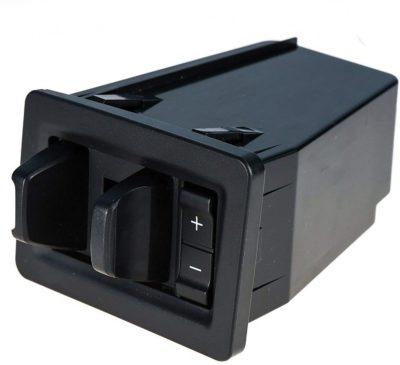
Editor’s Rating:
Where It Goes
In the 2015-2020 Ford F150, there is a blank cover down and to the right of the steering wheel. You pop that cover off and pull the wires out. Plug in this controller and snap it in.
Just as a note, these types of modules are not limited to Ford F150s. Other trucks like the Ram series and the Silverado series also have drop-in modules similar to this one. Just search your make, model and the words brake controller, and you will be able to see if there is an in-dash unit like this one for your vehicle.
Just be aware that some vehicles never had a factory tow option, and that means they are not wired for a brake controller. If they don’t have the wiring, chances are no one makes a dedicated dash controller for it.
How to Use It
Like most factory or factory looking devices, the Ensun In-Dash is as simple as can be to use. There’s a plus, a minus, and a slider for the override.
The really annoying thing about these devices is that there’s no display. Sometimes they work with the screens already in your truck. Sometimes they don’t; it depends entirely on how your vehicle is set up. Regardless, there’s not even a light-up LED gauge like the Spectrum controller has. You have to do it by feel, and that can take some getting used to.
Our Thoughts
These kinds of products only work for very specific circumstances. First, you have to have a truck, SUV, or crossover with a factory tow option. Second, at the time of purchasing the vehicle, the vehicle did not have that option selected. Most trucks fit the bill as many people will opt-out of the tow package when they buy them but might buy a trailer later on.
If that description fits you, and you value the factory look, these things are perfect. We recommend the Spectrum and the Compact IQ modules for everyone else who wants a factory look.
Pros
- Very easy to install
- Looks factory fresh
- Easy to operate
Cons
- There isn’t a module for every vehicle
- The lack of display can be annoying
The Full Guide to Trailer Brake Controllers
It’s always amazing how something so simple can be so complicated, isn’t it? A brake controller controls brakes; why are there so many buttons and knobs? Don’t worry, we put together this guide to take all the mystery out of it and get you stopping in comfort as fast as possible.
What Does a Brake Controller Do?
Long story short, some trailers have electric brakes. In order to utilize them, you need a brain that sends a signal to the brakes and controls them. A controller for the brakes, as it were. There are trailers that use a different, non-electric brake system, but they don’t need a controller.
The brain works in one of two ways. We mentioned them before, but brake controllers either use a bunch of sensors and are proportional, or they use a simple electronic timer and are time-based.
Proportional
Proportional brake controllers have taken over as the standard way controllers work. 9/10 of the controllers we recommend are proportional, from the inexpensive Reese Towpower to the bank-breaking Tekonsha Prodigy. That’s largely because they are safer and easier to drive with. A proportional controller applies braking force to the trailer proportionally to the tow vehicle, so the trailer brakes feel much more connected to the brake pedal.
Sensors and Calibration
They do this using a bunch of sensors, and that’s where the only downside to proportional controllers comes in. You have to do some work to make sure all those sensors are working correctly. Most modern brake controllers are self-leveling and self-calibrating, but you have to give them time to calibrate and test them out before going on a long haul. Some controllers need your help calibrating, like the Autowbrake controller we love so much.
There are still controllers for sale that are not self-leveling. We don’t recommend any of those; it’s not worth it.
Just be sure to read the instructions, you’ll be fine.
Time-Based
Brake controllers that are timed are much simpler than proportional timers. The way they work is that when you press on the brake pedal in your car, a countdown starts in the brake controller. As the controller counts down, the percentage of trailer brake power increases.
For the sake of simplicity, let’s say the delay is set to 10ms. That means as soon as you press the brake pedal, the trailer is at 0% brake, and the timer begins counting down from 10ms. At 9ms, the trailer starts braking at 10% power, at 5ms, the trailer is braking at 50% max power, and at 0ms, the trailer’s brakes are fully applied. You can adjust the amount of delay in most units.
Problems With Time-Based Braking
The issue with that is that the trailer becomes an anchor. It either won’t brake as quickly as the tow vehicle because the delay is too long, or it will be trying to stop much faster than the tow vehicle. Overbraking is the more dangerous outcome since the wheels on the trailer can lock completely. Not only does that wear out your tires and brakes much faster than a proportional system, but it makes for a very unpleasant experience.
Time-based controllers aren’t all bad, though. First off, they are way cheaper than proportional controllers. If you have a big trailer and you need a brake controller, but don’t have a lot of cash, by all means, get one. We recommend the Curt unit here. They are still way better than nothing.
They also are much simpler and don’t need calibration or leveling. That really shouldn’t be a decision-maker; brakes are not something you want to take the easy route with. But if you have an old farm truck, just need something good enough, and that doesn’t require any messing with – then time-based controllers are fine.

Installing a Brake Controller in Your Vehicle
One of the biggest questions you might have is, “can my car even use a brake controller?” The answer is yes, it’s just a matter of how much work you will have to do to install them. There are three loose categories that will affect how easy it is to install a brake controller.
Vehicles With a Brake Controller Option
If your car already has a tow package that includes an existing brake controller or spot for a brake controller, you are in luck. You just buy the module that fits in the factory location, like this one we recommend, and snap it in.
Vehicles That Are Pre-Wired for a Controller
Most of the time, if a vehicle can tow a trailer, it does have wiring for a brake controller. You simply have to mount the controller and buy the right adapter. The easiest thing to do, and the thing that will tell you instantly if your truck or SUV is pre-wired, is to google “make+model+year+brake controller wiring adapter.”
Once you have the adapter, you just install the controller in a place that you can reach it. Most people seem to prefer down and to the right of the steering wheel, but honestly, it’s up to you. Plug the controller into the adapter, plug the adapter into the factory harness, and you are good to go.
Vehicles That Are Not Pre-Wired
Suppose you have a smaller truck or another vehicle that isn’t normally known for towing. In that case, you probably don’t have factory wiring to tie into.
You have two options if your vehicle doesn’t have any factory wiring. The easiest is to just buy a wireless controller like the Echo controller we recommend. If your vehicle doesn’t even have a seven-pin output, we straight up recommend you don’t tow a big enough trailer to require brakes.
We know some people will do it anyway. Those people should get trailer-mounted wireless modules like the Tekonsha Prodigy. With those units, you can do all manner of DIY solutions.
The more difficult solution is to run your own wires. You only need 4, and they just need to go from your trailer connector to wherever you want to mount the controller. You can get away with 3 wires if you pull the power from somewhere else. Honestly, if you consider this option, you probably already know what you need to do and don’t need us saying anything.
Using the Controller
Every controller is a little different, so it’s important to read the directions. However, there are some general tips and tricks to help you get the most out of the experience.
- Calibrate the controller: Read the directions supplied and follow them to calibrate the controller. It’s an important step and one that is missed surprisingly often.\
- Do test stops before getting on major roads: If you can, get up to 45mph and do some test stops with your trailer off the main roads. You don’t want to discover that something is wrong after you merge onto the highway.
- Don’t be afraid of the adjustments. Read this guide. It’s written by Curt, who you’ll recognize as one of the major manufacturers we recommend. Not only does it have really straightforward instructions for getting your settings right. It also has pictures that illustrate a lot of the concepts we talk about in this article.
- Stop and pull over if you think something is wrong. If you’re worried about your brakes, or something feels off, stop driving and diagnose the issue. Brake controllers can malfunction or be installed incorrectly; if the brakes feel wrong, stop driving. It’s not worth it.
Enjoy a Worry-Free Adventure
Whether you are towing a trailer full of quads to tear up the dunes, or you are towing a bobcat to dig a new flower bed, you are probably going on an adventure. If you are towing a heavy trailer with no brake controller, your adventure will be more horror movie and less Indiana Jones. Don’t do that to yourself. Grab one of the black boxes we recommend, install it, and enjoy worry-free towing.
